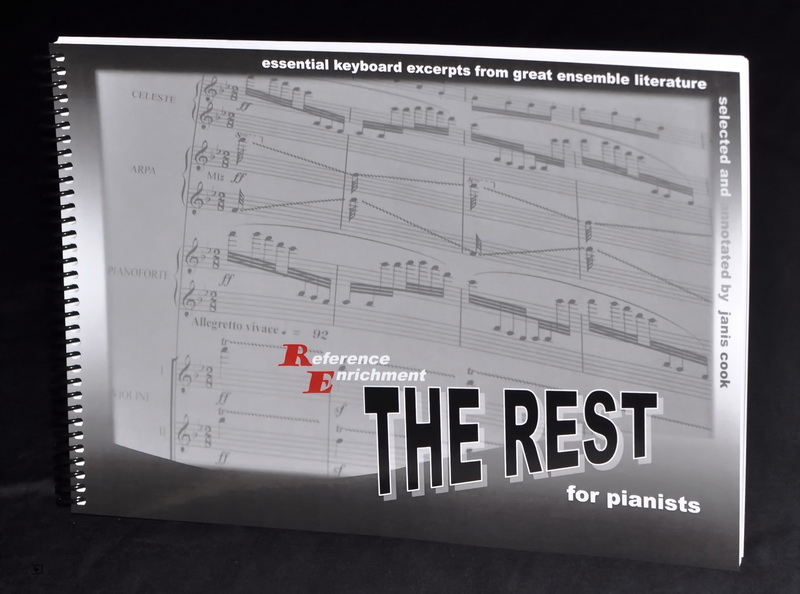The Rest: Reference & Enrichment for Pianists
(Essential Keyboard Excerpts from Great Ensemble Literature)
Selected and annotated by Janis Cook
Published by Janis Cook 2014 (http://cookandco.com.au/shop )
 Oftentimes, students and teachers can find anthologies of piano arrangements of orchestral music, but this new book is a completely new idea. The extracts contained therein are exactly reproduced from the orchestra scores. It is neither arranged nor simplified, thus pianists can truly play or study what the pianist actually plays in the selected orchestral works.
Oftentimes, students and teachers can find anthologies of piano arrangements of orchestral music, but this new book is a completely new idea. The extracts contained therein are exactly reproduced from the orchestra scores. It is neither arranged nor simplified, thus pianists can truly play or study what the pianist actually plays in the selected orchestral works.
The works here are by composers, old and new, and many of them were excellent pianists, themselves. The contents are arranged by composer in alphabetical order, rather than say, chronologically. As a result, it starts with Thomas Ades and finishes with Carl Maria von Weber, with tons of varying styles in between.
These are essential keyboard excerpts from mainstream orchestral and chamber repertoire, which heighten the skills and artistry required by every serious pianist; concise exercises in style, character and technique, which bring diverse aspects of pianism into sharp focus.
Teachers and students can use this stimulating collection as a different way to master specific technical skills, for Sight-reading development, for the study of the piano within the orchestral palette and its idiosyncratic timbre offering.
It is more of an exercise book; it is not a collection of beautifully chosen pieces for solo performance.
Of the modern repertoire that would not be so available in any form are pieces by Amy Beach, George Benjamin, Brett Dean, and Giya Kancheli. They sit alongside the more well-known composers such as Bartok, Beethoven, Bernstein, Brahms, Copland, Dvorak, Falla, Grainger, Haydn, Holst, Mendelssohn, Mussorgsky, Prokofiev, Puccini, Rachmaninov, Ravel, Respighi, Saint-Saens, Schubert, Strauss, Stravinsky and Tchaikovsky.
What is most useful is the author’s notes before each excerpt, in which she contexts the selection within the larger orchestral work from which it comes, as well as providing preparation and performance tips.
At the end of the book, there is some very instructive information about the piano in conducted works, extended techniques, piano in small ensembles, the Celeste, the pit, and some problem solving hints. Similarly, the orchestral layout diagrams of a Romantic orchestra, as well as the specific layout for Bartok’s Music for Strings, Percussion and Celeste are beneficial for study purposes.
This is a text that would have great application in the piano studio, as well as the classroom. In the NSW music curriculum, it would be a valued resource in the Preliminary and HSC study of “An Instrument and Its Repertoire”, “Music of the Last 25 Years”, “Music 1900-1945”, and many other topics.
